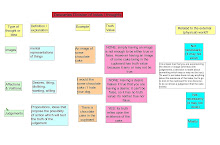
This understanding of the way we perceive the world tries to get around weaknesses of direct / naive realism by positing the idea of 'sense data' as intermediaries between the physical world and and our minds.
The 'sense data' allow us to form a representation of the 'real' physical world. The 'sense' data are 'mind-dependent': they do not only exist when we perceive the objects and they vary according to our perspective and circumstances. In this respect they allow for illusions, which are simply examples of the 'sense data' being unable to match up with reality accurately. Hallucinations are occasions when sense data occur without any corresponding stimulus in the physical world. And perceptual variation, is explained in the fact that 'sense data' are mind-dependent' rather than object dependent and therefore vary according the individual's different perspective or point of view on the world.
Although this theory seems to describe the way people experience the world more accurately than the clearly flawed naive realism, it has some very obvious problems of its own.
First of all it is not at all clear what the relationship is between the physical world and the 'sense data' that it seems to give rise to in us. If the sense data can be inaccurate as in the case of illusions, or entirely erroneous as in hallucinations, then how can we be sure that sense data actually represent anything at all?
Once the direct link between the supposed real physical world and our perception of it is called into doubt then the extent to which are representations of that world are accurate seems open to doubt, and a position of extreme scepticism seems possible.




















.jpg)







2 comments:
If extreme skepticism were correct why would you block it? Not that I am in favour of extreme skepticism. (See Notes on direct realism
Thanks for your comment, unfortunately I find it unintelligible. My fault I'm sure!
Post a Comment